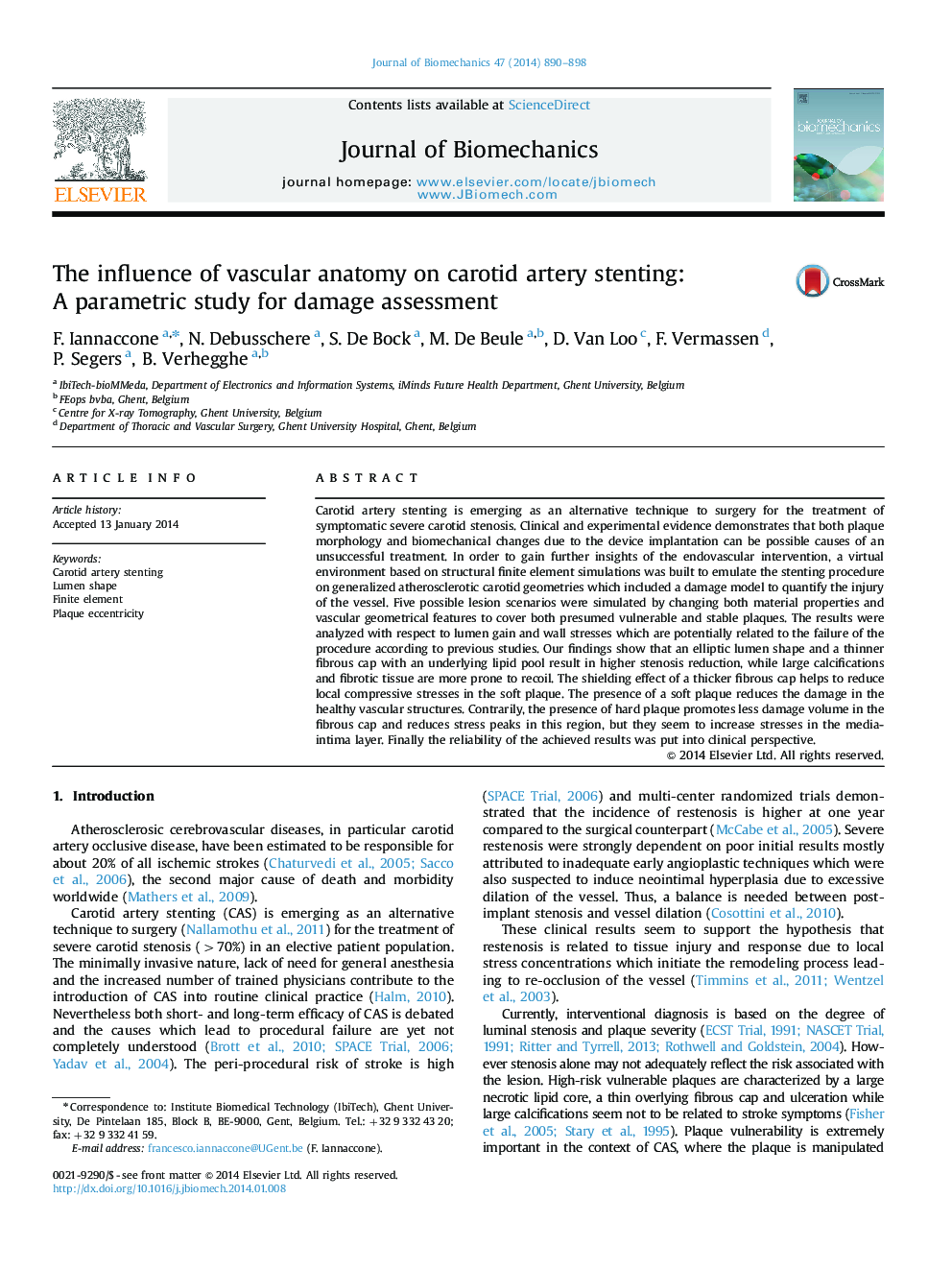| کد مقاله | کد نشریه | سال انتشار | مقاله انگلیسی | نسخه تمام متن |
|---|---|---|---|---|
| 10432221 | 910240 | 2014 | 9 صفحه PDF | دانلود رایگان |
عنوان انگلیسی مقاله ISI
The influence of vascular anatomy on carotid artery stenting: A parametric study for damage assessment
ترجمه فارسی عنوان
تأثیر آناتومی عروق بر روی استنت گذاری شریان کاروتید: مطالعه پارامتری برای ارزیابی خسارت
دانلود مقاله + سفارش ترجمه
دانلود مقاله ISI انگلیسی
رایگان برای ایرانیان
کلمات کلیدی
استنت گذاری شریان کاروتید، شکل لومن، المان محدود، غربالگری پلاک،
ترجمه چکیده
ترشح شریان کاروتید به عنوان یک تکنیک جایگزین برای جراحی برای درمان تنگی کاروتید شدید علامت دار ظاهر می شود. شواهد بالینی و تجربی نشان می دهد که هر دو مورفولوژی پلاک و تغییرات بیومکانیک به علت کاشت دستگاه می تواند علل احتمالی درمان ناموفق باشد. برای به دست آوردن بینش بیشتر از مداخله آندوسکوپی، یک محیط مجازی بر اساس شبیه سازی عناصر ساختاری محدود به منظور تقلید از روش استنت گذاری در هندسه های کاروتید متعارف متعارف ساخته شده است که شامل یک مدل آسیب برای اندازه گیری صدمه از کشتی است. پنج سناریو ضایعه ممکن با تغییر خواص مواد و ویژگی های هندسی عروقی برای پوشش پلاک های آسیب پذیر و پایدار قابل قبول شبیه سازی شده اند. نتایج با توجه به افزایش لنفوم و تنش دیواره که به طور بالقوه با شکست روش همراه با مطالعات قبلی مرتبط است، مورد تجزیه و تحلیل قرار گرفت. یافته های ما نشان می دهد که شکل لومن بیضوی و فیکسچر نازک با کلاهک پایه لیپید موجب کاهش استنوز می شود، در حالی که کلسیفیکس های بزرگ و بافت فیبروتیک بیشتر مستعد ابتلا به زخم هستند. اثر حفاظتی یک سفت فیبری ضخیم به کاهش تنش فشاری محلی در پلاک نرم کمک می کند. حضور پلاک نرم باعث کاهش آسیب در ساختارهای عروقی سالم می شود. برعکس، حضور پلاک سخت موجب کاهش میزان آسیب در کلاهک فیبرنوری می شود و فشارهای استرس را در این منطقه کاهش می دهد، اما به نظر می رسد که تنش ها در لایه های رسانه ای درونی افزایش می یابد. در نهایت قابلیت اطمینان نتایج به دست آمده از دیدگاه بالینی قرار گرفت.
موضوعات مرتبط
مهندسی و علوم پایه
سایر رشته های مهندسی
مهندسی پزشکی
چکیده انگلیسی
Carotid artery stenting is emerging as an alternative technique to surgery for the treatment of symptomatic severe carotid stenosis. Clinical and experimental evidence demonstrates that both plaque morphology and biomechanical changes due to the device implantation can be possible causes of an unsuccessful treatment. In order to gain further insights of the endovascular intervention, a virtual environment based on structural finite element simulations was built to emulate the stenting procedure on generalized atherosclerotic carotid geometries which included a damage model to quantify the injury of the vessel. Five possible lesion scenarios were simulated by changing both material properties and vascular geometrical features to cover both presumed vulnerable and stable plaques. The results were analyzed with respect to lumen gain and wall stresses which are potentially related to the failure of the procedure according to previous studies. Our findings show that an elliptic lumen shape and a thinner fibrous cap with an underlying lipid pool result in higher stenosis reduction, while large calcifications and fibrotic tissue are more prone to recoil. The shielding effect of a thicker fibrous cap helps to reduce local compressive stresses in the soft plaque. The presence of a soft plaque reduces the damage in the healthy vascular structures. Contrarily, the presence of hard plaque promotes less damage volume in the fibrous cap and reduces stress peaks in this region, but they seem to increase stresses in the media-intima layer. Finally the reliability of the achieved results was put into clinical perspective.
ناشر
Database: Elsevier - ScienceDirect (ساینس دایرکت)
Journal: Journal of Biomechanics - Volume 47, Issue 4, 3 March 2014, Pages 890-898
Journal: Journal of Biomechanics - Volume 47, Issue 4, 3 March 2014, Pages 890-898
نویسندگان
F. Iannaccone, N. Debusschere, S. De Bock, M. De Beule, D. Van Loo, F. Vermassen, P. Segers, B. Verhegghe,
